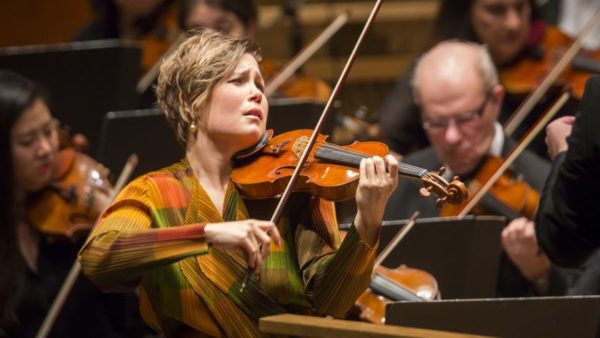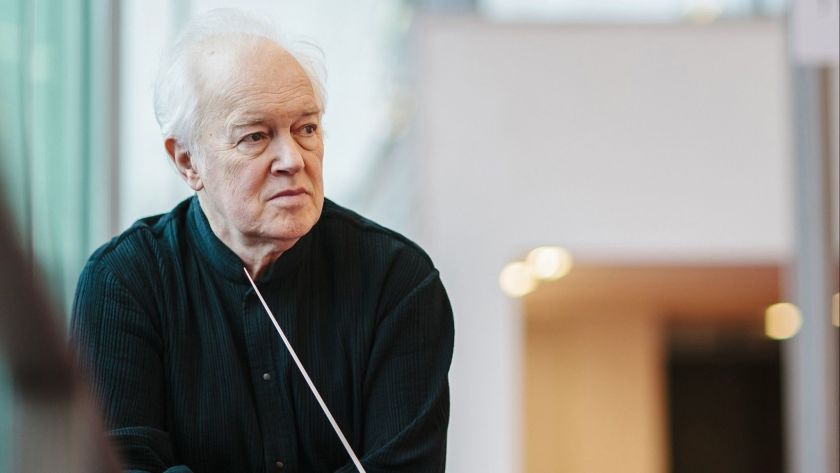When Chuck Berry first sang “Roll over Beethoven, tell Tchaikovsky the news!” in 1956, he was trumpeting the rise of rock ‘n’ roll and, perhaps, forecasting the decline of classical music.
Sixty-four years later, rock’s supremacy has been overturned by hip-hop, reggaeton, trap and a host of dance-happy electronic music styles. And Ludwig van Beethoven — whose 250th birthday is now being celebrated here, there and everywhere — is bigger and more formidable than ever.
Indeed, Beethoven still stands as a towering composer of epic music and as an exemplar of an art form that has thrived for centuries. A recent Google search for “Beethoven 250″ yields 16 million results, which pales compared to the 103 million results that “Beethoven” alone brings up.
“We have a fidelity to Beethoven,” said San Diego Symphony CEO Martha Gilmer, who worked closely with the orchestra’s new music director, Rafael Payare, to program the orchestra’s ongoing “Beethoven at 250″ celebration. (This month’s full schedule of performances by the symphony appears below.)
“Our ‘Beethoven at 250′ concerts are based on the values he embraces, including his incredible commitment to humanity, as well as the things that make him an innovator,” Gilmer continued. “Of course, anyone leading an orchestra wants to demonstrate their understanding of Beethoven with the orchestra. He has certainly inspired many musicians across time and boundaries, which is great.”
That is precisely why so many other orchestras around the world are also devoting part or all of their current seasons to Beethoven, who died in 1827 at the age of 56. It may also be why a lock of Beethoven’s hair was auctioned last summer at Sotheby’s in London for about $44,500.
That amount eclipsed the $35,000 paid for a lock of John Lennon’s hair at a 2016 auction. Lennon, incidentally, sang lead vocals on “Roll Over Beethoven” during The Beatles’ early years and later based his Fab Four song, “Because,” on playing the chords of Beethoven’s “Moonlight Sonata” backwards.
Then again, even if Beethoven hadn’t lost 60 percent of his hearing by the time he was 31 and gone completely deaf 15 years later — and even if he hadn’t inspired a 1987 series of Andy Warhol screen-prints — he might still qualify as classical music’s first rock star, for better and worse.
A famously temperamental rule-breaker, Beethoven chaffed at society’s norms and chastised at least one concert audience for failing to appropriately demonstrate its appreciation of his work. Composing whenever his muse struck, he feverishly wrote parts of some of his compositions on napkins and restaurant menus.
A truly tortured genius who had entirely lost his hearing by the time he composed and conducted his monumental Ninth Symphony, Beethoven was well aware of his failings in his everyday life. Or, as he once wrote: “Everything I do apart from music is badly done and stupid.” He died of cirrhosis of the liver, which is not surprising since he reportedly drank up to three bottles of wine a day.
Beethoven’s all-embracing music helped to irrevocably expand the dynamic range of the piano and of orchestras. His panoramic compositions reflect his complex emotional makeup and — equally important — his visceral opinions on politics, class divisions, war and the world at large.

Violinist Leila Josefowicz (center) will perform two concerts with the San Diego Symphony this month as part of the orchestra’s “Beethoven at 250″ celebration.
(Photo by Chris Lee / Courtesy of San Diego Symphony)
‘Get another profession!’
Today, Beethoven’s vibrant works continue to inspire awe for listeners and performers alike, including San Diego Symphony Principal Guest Conductor Edo de Waart.
“With someone like Beethoven, you always fear that you do not live up to his greatness and the greatness of what he wrote,” said the Dutch-born de Waart, who will conduct nine “Beethoven at 250″ concerts here this month.
“You think: ‘Oh, my god, if he walked in at this moment and heard you, what would he say? ‘Get another profession!’ Or: ‘That’s pretty good. …’ ”
Beethoven’s influence also extends to at least two 20th century technologies that he couldn’t have dreamed of during his lifetime. The first commercially available 33⅓ LP, released in 1931, featured his Fifth Symphony. The first generation of CDs, which came out in the 1980s, were given a playing-time duration of 75 minutes — specifically so that Beethoven’s Ninth Symphony could be heard, without interruption, in full.
His impact a century earlier was so great that, in 1845 — just 13 years after he died — his German hometown of Bonn staged its first “Beethoven Festival.” Attendees could buy handmade Beethoven neckties, Beethoven pants and Beethoven cigars (presumably non-exploding). The 2020 edition of the festival will be held March 13-22 in Bonn, which is spending $5.7 million to celebrate his legacy.
An estimated 1,000 concerts, festivals, opera performances and exhibitions will be held this year to celebrate Beethoven’s legacy throughout Germany, where the government has committed $33 million in funding.
Fortunately, no international trips are necessary to enjoy his music performed live.
The San Diego Symphony’s “Beethoven at 250″ series, which kicked off Nov. 1 and concludes May 24, will feature 10 concerts this month between Friday and Jan. 25. With the exception of the Jan. 14 chamber-music performance at Conrad Prebys Performing Arts Center in La Jolla, the other nine concerts take place at Copley Symphony Hall downtown and will be conducted by de Waart.
“Everything Beethoven wrote was eye-opening,” said de Waart in a recent phone interview from Chicago, where he was guest-conducting that city’s famed orchestra.
His sentiments are shared by violin star Leila Josefowicz, who will perform here with de Waart and the San Diego Symphony on Jan. 17 and 18.
“After he emerged, Beethoven influenced all composers from then on,” Josefowicz said, speaking from her home in New York.

Dutch-born conductor Edo de Waart will lead the San Diego Symphony in nine Beethoven concerts this month. “Beethoven really scared me,” he recalls of the first time he conducted a work by the iconic composer.
(Courtesy photo by Jesse Willems)
‘Beethoven pushed the envelope’
One of those is John Adams, perhaps the most celebrated contemporary classical composer to rise to prominence in the past 50 years. His 2015 album, “Absolute Jest,” features two compositions by Adams that were directly inspired by Beethoven’s late string quartets. Adams subsequently composed Second Quartet, which was inspired by Beethoven’s Piano Sonata No. 31, Op. 110.
“We have music that we love so much that we kind of want to get under the skin of that composer,” Adams told NPR in 2015. “For me taking not so much melodies but just little harmonic fragments, like fractals, from Beethoven and putting them through the black box of my own musical personality was real stimulation to my invention.”
By coincidence, de Waart was one of Adams’ earliest and most profound champions. During his tenure as the San Francisco Symphony’s Music Director, de Waart appointed Adams as the orchestra’s composer-in-residence in 1982. De Waart went on to record such pioneering compositions by Adams as “Shaker Loops,” “Harmonium” and “Nixon in China,” and his endorsement helped propel Adams on to the world stage.
By another coincidence, Josefowicz proudly estimates that she has performed about 100 concerts of Adams’ music over the past 20 years. More than a few of those concerts have been conducted by de Waart.
By no coincidence whatsoever, the San Diego Symphony’s Jan. 17 and 18 concerts will feature de Waart conducting Beethoven’s Grosse Fuge and Adams’ Violin Concerto, the latter of which will showcase Josefowicz as its soloist.
This carefully planned juxtaposition will, de Waart and Josefowicz agree, help listeners trace the vital through-line that extends from Beethoven’s music to that of Adams.
“I definitely do think you they share commonalities,” the violinist said. “Especially with the Beethoven Fifth, which has such memorable and strong motifs that are incredibly well-written. The genius and simplicity is something Adams also has in common with Beethoven. Even though they come from incredibly different times, with different musical languages, Beethoven and Adams both have great harmonic power.
“Beethoven pushed the envelope, and so has Adams. Every piece and genre of music was new at one time, and every piece was unfamiliar at a certain point.”
De Waart readily concurs.
“I have done a lot of concerts of Adams’ and Beethoven’s music together,” he said.
“As Adams once said to me: ‘Well, I’m sharing the bed with Beethoven again!’ It works out very well — and it’s always enriching.”
Under the influence
How influential was Beethoven beyond the world of classical music? Here are some examples.
• In 1943, TS Eliot titled a set of his poems “Four Quartets” to acknowledge how much he was inspired by Beethoven’s Four Quartets.
• In 1972, “Ode to Joy,” the final movement of Beethoven’s 9th Symphony was declared as the official anthem of the European Union by the Council of Europe.
• In 1973, England’s Electric Light Orchestra — whose records and concerts combined a rock band and a string quartet — recorded an eight-minute version of “Roll Over Beethoven” that combined the classic Chuck Berry song of the same name with the opening of Beethoven’s Fifth Symphony and parts of its first movement.
• In 1976, Walter Murphy & The Big Apple Band topped the U.S. singles chart with “A Fifth Of Beethoven,” their disco version of the first movement of Beethoven’s Fifth Symphony.
• In 1984, Billy Joel used the theme from Beethoven’s Sonata Pathetique for the refrain of his love song, “This Night.”
• In 2003, hip-hop star Nas sampled Beethoven’s “Für Elise” on his rap hit “I Can.”
• In 2005, Bright Eyes’ leader Conner Oberst used the melody to “Ode to Joy” as the inspiration for his song “Road to Joy.”
• In 2009, the French band Heavenly recorded a heavy-metal version of “Ode to Joy.”
• In 2012, Alicia Keys’ “Piano Mash Up” included her performing part of Beethoven’s “Moonlight Sonata.”
• In 2015, Steve Hackman debuted “Beethoven V. Coldplay,” in which he turns the composer’s landmark Third Symphony, Eroica, into an oratorio by mixing it with the lyrics and melodies of such Coldplay hits as “Yellow” and “Clocks.” Hackman will conduct San Diego Symphony’s Feb. 15 “Beethoven V. Coldplay” concert, which will feature three lead vocalists.
Did you know?
When the Schuppanzigh Quartet refused to play the last movement of Beethoven’s String Quartet No.13 in 1826, the irate composer snapped: “What care I about you and your bloody fiddles?”
San Diego Symphony presents “Beethoven at 250″
Friday and Saturday at 8 p.m. and next Sunday at 2 p.m.: Beethoven Piano Concerto No. 1, featuring Edo de Waart, conductor, and Emanuel Ax, piano, and Beethoven’s Leonore Overture No. 3, Symphony No. 4
Tuesday, Jan. 14, at 7:30 p.m.: Beethoven Piano Trio in C Minor and Piano Sonata in D Major: Pastoral, featuring Shai Wosner, piano; and Beethoven Septet in E-flat Major (at Conrad Prebys Performing Arts Center in La Jolla).
Friday, Jan. 17, and Saturday, Jan. 18, at 8 p.m.: Beethoven’s Symphony No. 5, featuring Edo de Waart, conductor, Leila Josefowicz, violin, Beethoven’s Grosse Fuge and John Adams’ Violin Concerto
Sunday, Jan. 19, at 2 p.m.: “Beyond The Score” — Beethoven’s Symphony No. 5, featuring Edo de Waart, conductor
Friday, Jan. 24, and Saturday, Jan. 25, at 8 p.m.: Beethoven’s Symphony No. 6: Pastoral, featuring Edo de Waart, conductor, Beethoven’s Overture to Egmont and Haydn’s Symphony No. 92: Oxford
Where: Jacobs Music Center’s Copley Symphony Hall, 750 B. St., downtown
Tickets: $23 to $105 for all concerts except the Jan. 14 concert in La Jolla, for which prices range from $40 to 65
Phone: (619) 235-0804